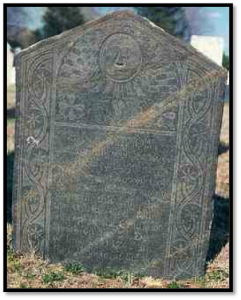By Walter W. Woodward
(c) Connecticut Explored Inc. Spring 2015
Subscribe/Buy the Issue!
 In the early 1700s cemeteries in Connecticut’s Puritan towns took on a new and vital role in community social and cultural life and gravestone carvers became our earliest “rock stars.” Where once the houses of the first settlers, clustered around village greens, had been the source of local identity and unity, the second and third generations’ dispersal to outlying farmsteads made day-to-day, face-to-face community-wide interaction a thing of the past. To counteract the increasing isolation, town fathers and local ministers conspired to transform their local cemeteries into vibrant symbols of community members’ connections not just to God but also to their past and to each other. Almost every aspect of Puritan death and burial rituals, the historian John Brooke noted in his essay in Material Life in Early America (Northeastern Press, 1988), were changed. Most notable were the transformations in the design of and importance placed on carved gravestones.
In the early 1700s cemeteries in Connecticut’s Puritan towns took on a new and vital role in community social and cultural life and gravestone carvers became our earliest “rock stars.” Where once the houses of the first settlers, clustered around village greens, had been the source of local identity and unity, the second and third generations’ dispersal to outlying farmsteads made day-to-day, face-to-face community-wide interaction a thing of the past. To counteract the increasing isolation, town fathers and local ministers conspired to transform their local cemeteries into vibrant symbols of community members’ connections not just to God but also to their past and to each other. Almost every aspect of Puritan death and burial rituals, the historian John Brooke noted in his essay in Material Life in Early America (Northeastern Press, 1988), were changed. Most notable were the transformations in the design of and importance placed on carved gravestones.
Seventeenth-century gravestones had been simple rough stone slabs or shaped stones carved with medieval death’s-heads, crossed bones, scythes, and other symbols of death. The 18th century saw those death’s-heads transform into ever-more refined (and far less threatening) images of winged faces representing the souls of the people who had died. Vines, tendrils, and other signs indicating the soul’s transition from death to new life at the moment of Christian resurrection replaced symbols of death, and stones began to include life-summarizing epitaphs. In a society that normally rejected artistic expression as too worldly, the town cemetery became a gallery of vivid remembrance. One of the few places where all town members frequently gathered (thanks to colonial mortality rates), the “yard” became an essential site of local identity, self-expression, and community.
Stone carvers, each with a distinct approach to depicting the story of remembrance, became well known and their work widely distributed. Their particular stylistic patterns remain clearly recognizable after nearly three centuries of New England wind and weather.
One of the rock stars of Puritan gravestone carving was Benjamin Collins of Columbia, Connecticut. A patriarch of the “Eastern Connecticut Ornamental Style,” his signed stones date from 1726 to 1759, the year he died. Collins brought a cabinet-maker’s sense of style to his work that made it very popular. His delicate, leaf-like border panels and feathered, Indian-headdress-like-wings grace stones in Pachaug, Danielson, Ledyard, Hebron, Tolland, Scotland, Norwich, Colchester, New London, Lebanon, Plainfield, Coventry, Franklin, Windham, and Mansfield Center. In Columbia alone, there are 41 Collins markers, many carved from the distinctively blue-hued schist he quarried at his own farm. Collins made rich use of symbolism, such as the winged hourglass (“time flies”) carved into the marker of his son Zelotes, and the sun, moon, and stars (together symbolizing the promise of the Resurrection) he placed on the stone of the wealthy Zerviah Buckingham. In almost every stone, he carved a heart, a symbol of eternal life. His graceful style made him a recognized master of the most important art form of his time and region. Two of his sons, Josiah and Zerubabel, followed in their father’s footsteps. Zerubabel became a well-known gravestone carver in his own right, working until his death in 1797. He carved his father’s gravestone using his own distinctive style.
Almost every Connecticut town has a cemetery where you can view the stonework of celebrated early New England artists such as Benjamin Collins while paying respects to the towns’ early inhabitants. One clear spring afternoon, make a thermos of tea and go see the Puritan past in a new and artful light.
Walter W. Woodward is the Connecticut state historian.For information about upcoming talks he is giving visit the Office of the State Historian’s Web site at cthistory.org.
Explore!
“Beauty in a Gravestone,” Winter 2010/2011
For more information about gravestones in Connecticut visit the Connecticut Gravestone Network at ctgravestones.com.
